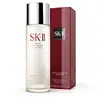What's inside
What's inside
 Key Ingredients
Key Ingredients

No key ingredients
 Benefits
Benefits

 Concerns
Concerns

 Ingredients Side-by-side
Ingredients Side-by-side

Water
Skin ConditioningAlgae Extract
EmollientGlycerin
HumectantMethyl Gluceth-20
HumectantBis-PEG-18 Methyl Ether Dimethyl Silane
EmollientSucrose
HumectantYeast Extract
Skin ConditioningSesamum Indicum Seed Oil
EmollientMedicago Sativa Seed Powder
Skin ConditioningPrunus Amygdalus Dulcis Seed Meal
AbrasiveHelianthus Annuus Seedcake
AbrasiveEucalyptus Globulus Leaf Oil
PerfumingSodium Gluconate
Skin ConditioningCopper Gluconate
Skin ConditioningCalcium Gluconate
HumectantMagnesium Gluconate
Skin ConditioningZinc Gluconate
Skin ConditioningTocopheryl Succinate
AntioxidantNiacin
SmoothingSesamum Indicum Seed Powder
Skin ConditioningCitrus Aurantifolia Peel Extract
CleansingLaminaria Digitata Extract
Skin ProtectingLaminaria Saccharina Extract
Skin ProtectingPlankton Extract
Skin ConditioningPalmaria Palmata Extract
Skin ProtectingSodium Hyaluronate
HumectantButylene Glycol
HumectantCaffeine
Skin ConditioningDipotassium Glycyrrhizate
HumectantAcetyl Hexapeptide-8
HumectantGlycereth-26
HumectantAlcaligenes Polysaccharides
EmollientTrehalose
HumectantLactobacillus Ferment
Skin ConditioningMaris Sal
Skin ConditioningTourmaline
Urea
BufferingSodium PCA
HumectantGlycine Soja Protein
EmulsifyingGlycosaminoglycans
EmollientGlycine Soja Seed Extract
Skin ConditioningTetradecyl Aminobutyroylvalylaminobutyric Urea Trifluoroacetate
Skin ConditioningCaprylyl Glycol
EmollientPEG-8
HumectantMagnesium Chloride
Calcium Chloride
AstringentSodium Sulfate
Potassium Phosphate
BufferingPotassium Nitrate
SoothingPentylene Glycol
Skin ConditioningTriacetin
AntimicrobialLecithin
EmollientPPG-5-Ceteth-20
EmulsifyingJojoba Wax PEG-120 Esters
Polysorbate 20
EmulsifyingPolyquaternium-51
Skin ConditioningHydroxypropyl Cyclodextrin
MaskingAlcohol Denat.
AntimicrobialParfum
MaskingLimonene
PerfumingLinalool
PerfumingHydroxycitronellal
PerfumingCitronellol
PerfumingGeraniol
PerfumingBHT
AntioxidantDisodium EDTA
Potassium Sorbate
PreservativeChlorphenesin
AntimicrobialSorbic Acid
PreservativePhenoxyethanol
PreservativeWater, Algae Extract, Glycerin, Methyl Gluceth-20, Bis-PEG-18 Methyl Ether Dimethyl Silane, Sucrose, Yeast Extract, Sesamum Indicum Seed Oil, Medicago Sativa Seed Powder, Prunus Amygdalus Dulcis Seed Meal, Helianthus Annuus Seedcake, Eucalyptus Globulus Leaf Oil, Sodium Gluconate, Copper Gluconate, Calcium Gluconate, Magnesium Gluconate, Zinc Gluconate, Tocopheryl Succinate, Niacin, Sesamum Indicum Seed Powder, Citrus Aurantifolia Peel Extract, Laminaria Digitata Extract, Laminaria Saccharina Extract, Plankton Extract, Palmaria Palmata Extract, Sodium Hyaluronate, Butylene Glycol, Caffeine, Dipotassium Glycyrrhizate, Acetyl Hexapeptide-8, Glycereth-26, Alcaligenes Polysaccharides, Trehalose, Lactobacillus Ferment, Maris Sal, Tourmaline, Urea, Sodium PCA, Glycine Soja Protein, Glycosaminoglycans, Glycine Soja Seed Extract, Tetradecyl Aminobutyroylvalylaminobutyric Urea Trifluoroacetate, Caprylyl Glycol, PEG-8, Magnesium Chloride, Calcium Chloride, Sodium Sulfate, Potassium Phosphate, Potassium Nitrate, Pentylene Glycol, Triacetin, Lecithin, PPG-5-Ceteth-20, Jojoba Wax PEG-120 Esters, Polysorbate 20, Polyquaternium-51, Hydroxypropyl Cyclodextrin, Alcohol Denat., Parfum, Limonene, Linalool, Hydroxycitronellal, Citronellol, Geraniol, BHT, Disodium EDTA, Potassium Sorbate, Chlorphenesin, Sorbic Acid, Phenoxyethanol
 Reviews
Reviews

Ingredients Explained
These ingredients are found in both products.
Ingredients higher up in an ingredient list are typically present in a larger amount.
Butylene Glycol (or BG) is used within cosmetic products for a few different reasons:
Overall, Butylene Glycol is a safe and well-rounded ingredient that works well with other ingredients.
Though this ingredient works well with most skin types, some people with sensitive skin may experience a reaction such as allergic rashes, closed comedones, or itchiness.
Learn more about Butylene GlycolPentylene glycol is typically used within a product to thicken it. It also adds a smooth, soft, and moisturizing feel to the product. It is naturally found in plants such as sugar beets.
The hydrophilic trait of Pentylene Glycol makes it a humectant. As a humectant, Pentylene Glycol helps draw moisture from the air to your skin. This can help keep your skin hydrated.
This property also makes Pentylene Glycol a great texture enhancer. It can also help thicken or stabilize a product.
Pentylene Glycol also acts as a mild preservative and helps to keep a product microbe-free.
Some people may experience mild eye and skin irritation from Pentylene Glycol. We always recommend speaking with a professional about using this ingredient in your routine.
Pentylene Glycol has a low molecular weight and is part of the 1,2-glycol family.
Learn more about Pentylene GlycolSorbic Acid is a preservative. It is the most commonly used food preservative in the world.
Sorbic Acid is a natural antibiotic and highly effective at preventing the growth of fungus. It is less effective against bacteria.
Potassium Sorbate, another commonly-used preservative, is the potassium salt of Sorbic Acid.
Sorbic Acid may worsen eczema. We recommend speaking with a professional if you have any concerns.
Potassium sorbate and sorbic acid can be found in baked goods, cheeses, dried meats, dried fruit, ice cream, pickles, wine, yogurt, and more.
Learn more about Sorbic AcidWater. It's the most common cosmetic ingredient of all. You'll usually see it at the top of ingredient lists, meaning that it makes up the largest part of the product.
So why is it so popular? Water most often acts as a solvent - this means that it helps dissolve other ingredients into the formulation.
You'll also recognize water as that liquid we all need to stay alive. If you see this, drink a glass of water. Stay hydrated!
Learn more about Water